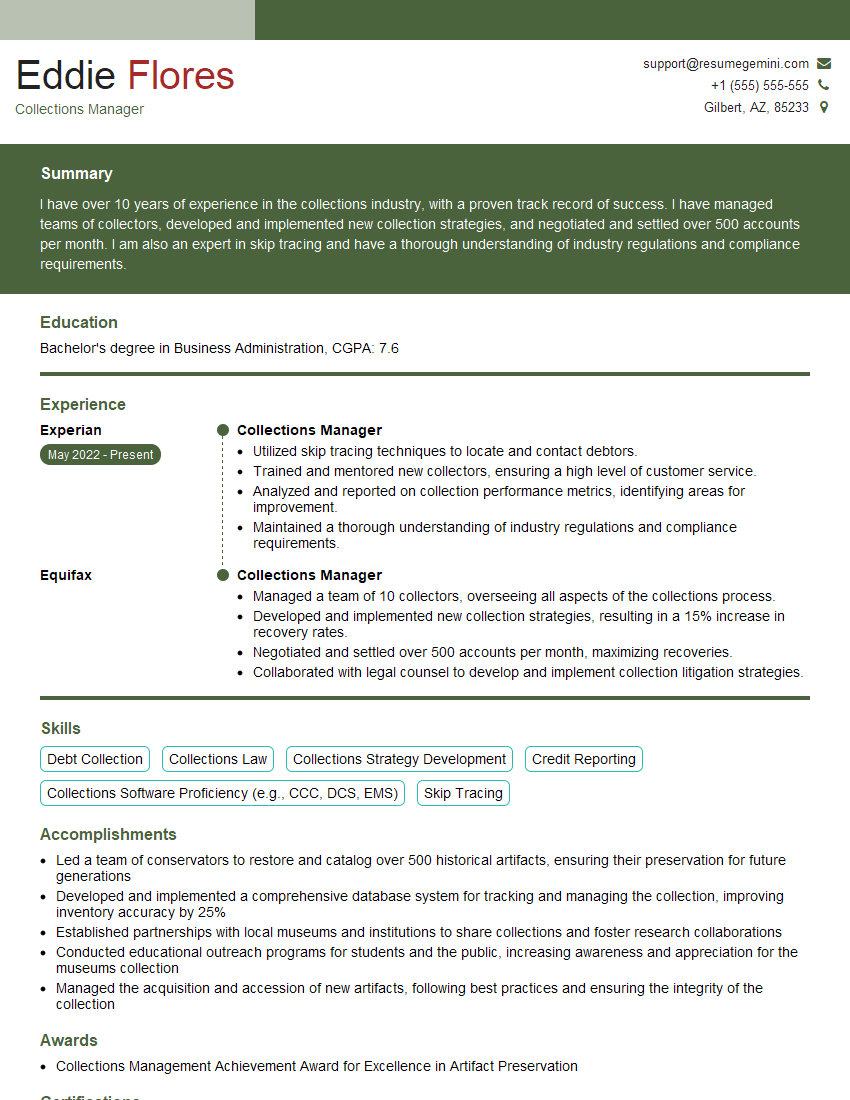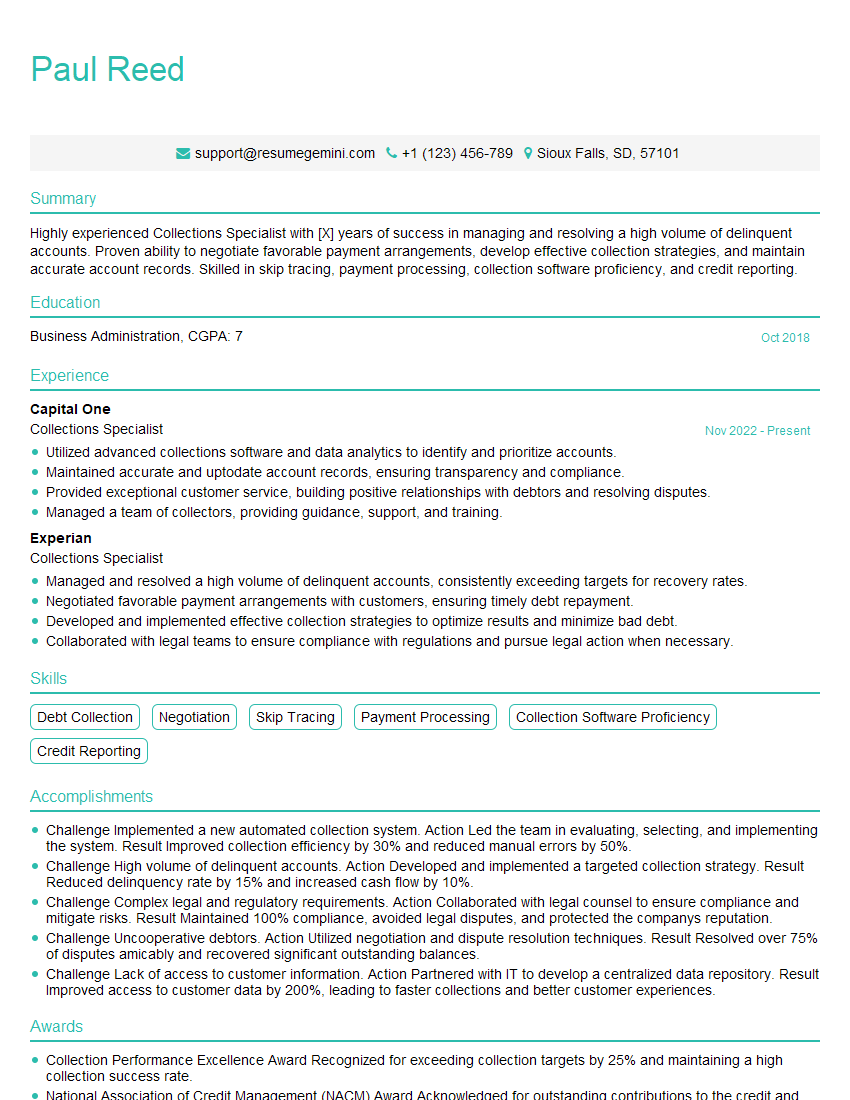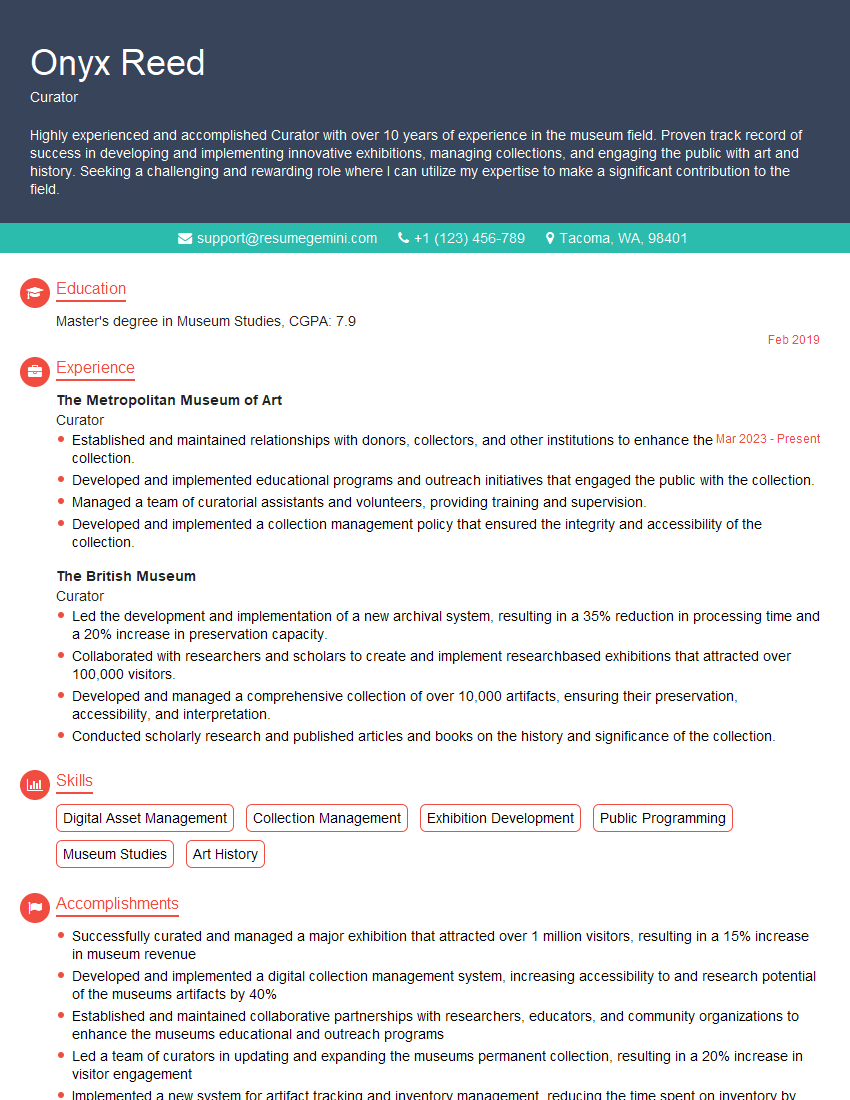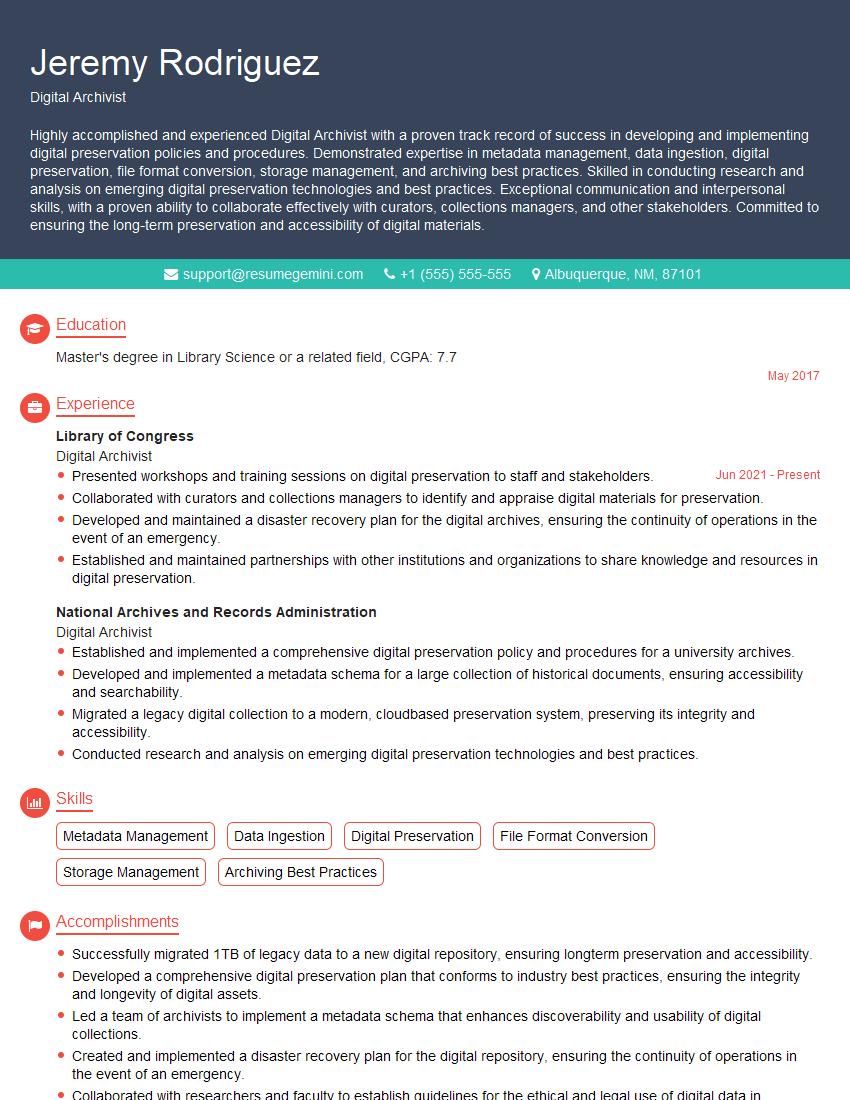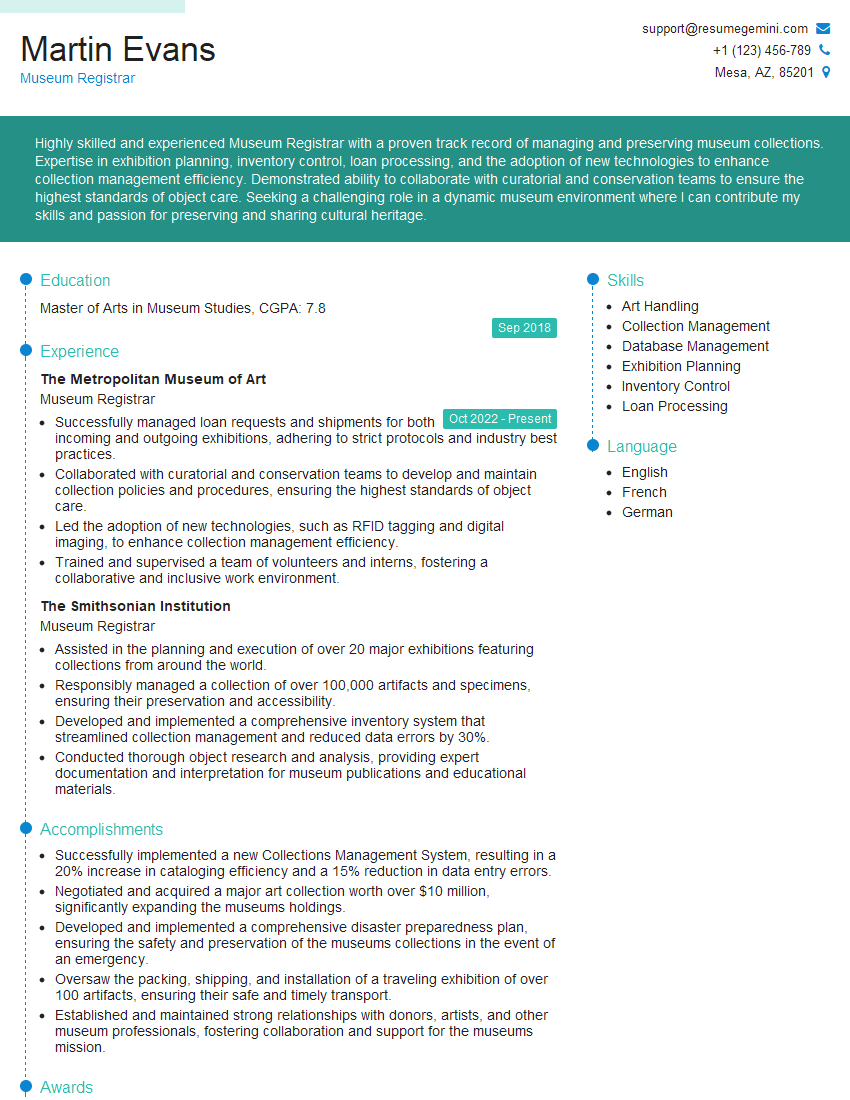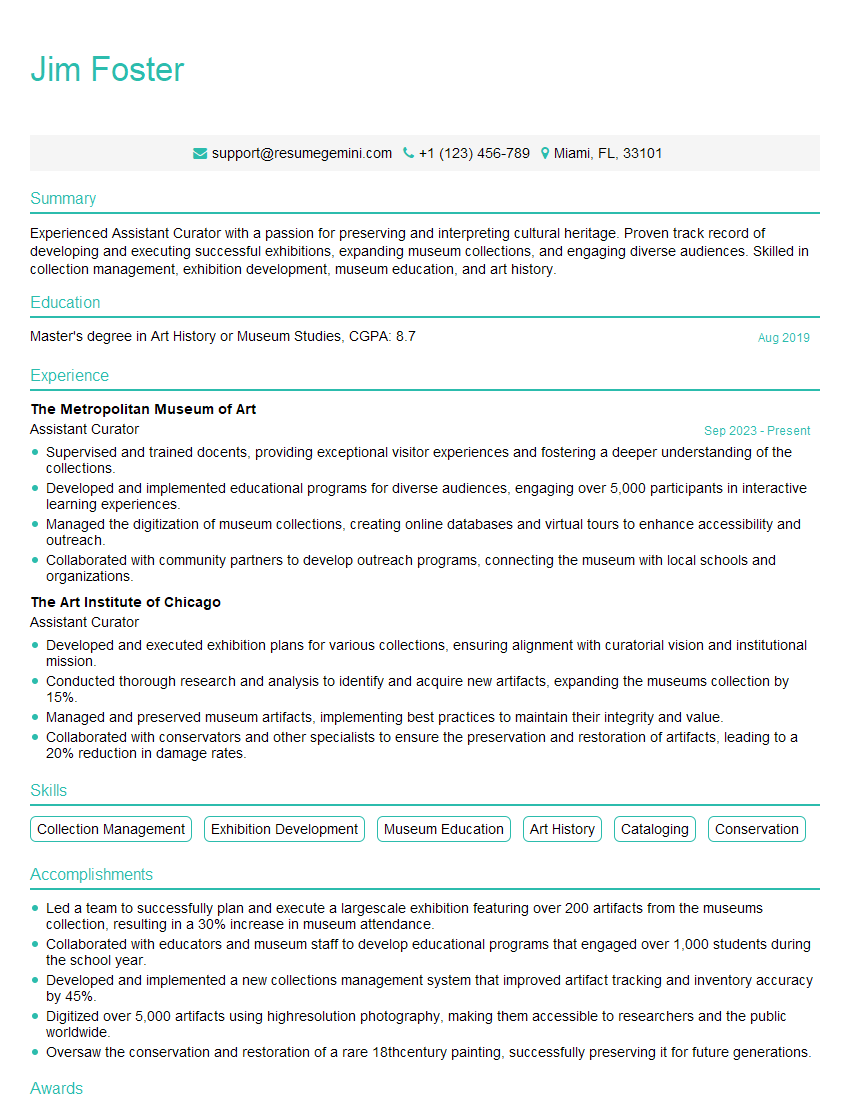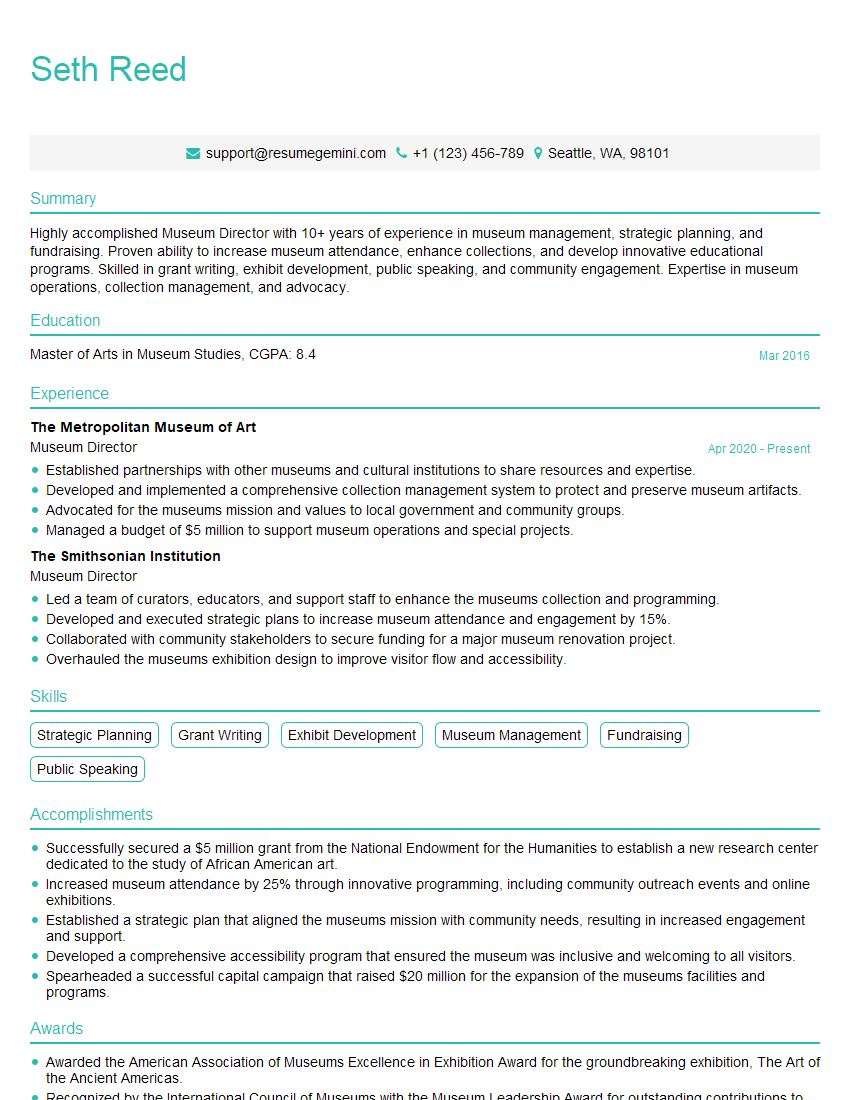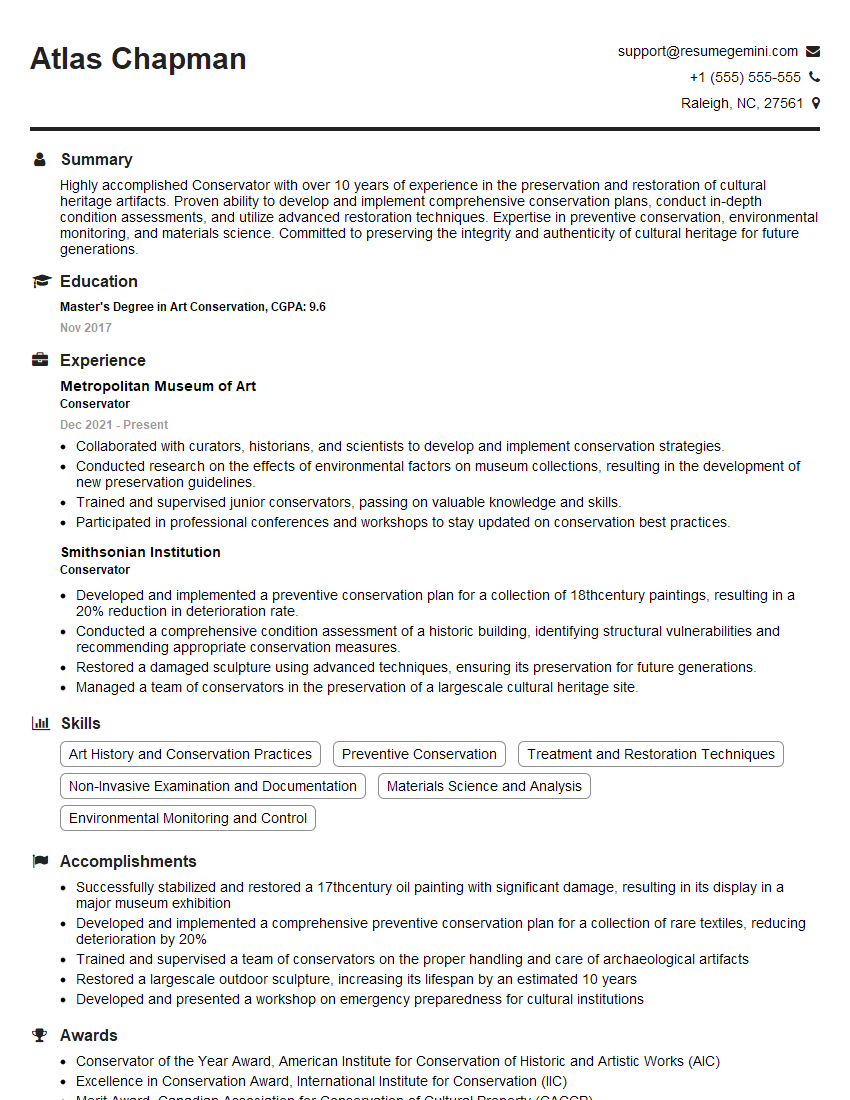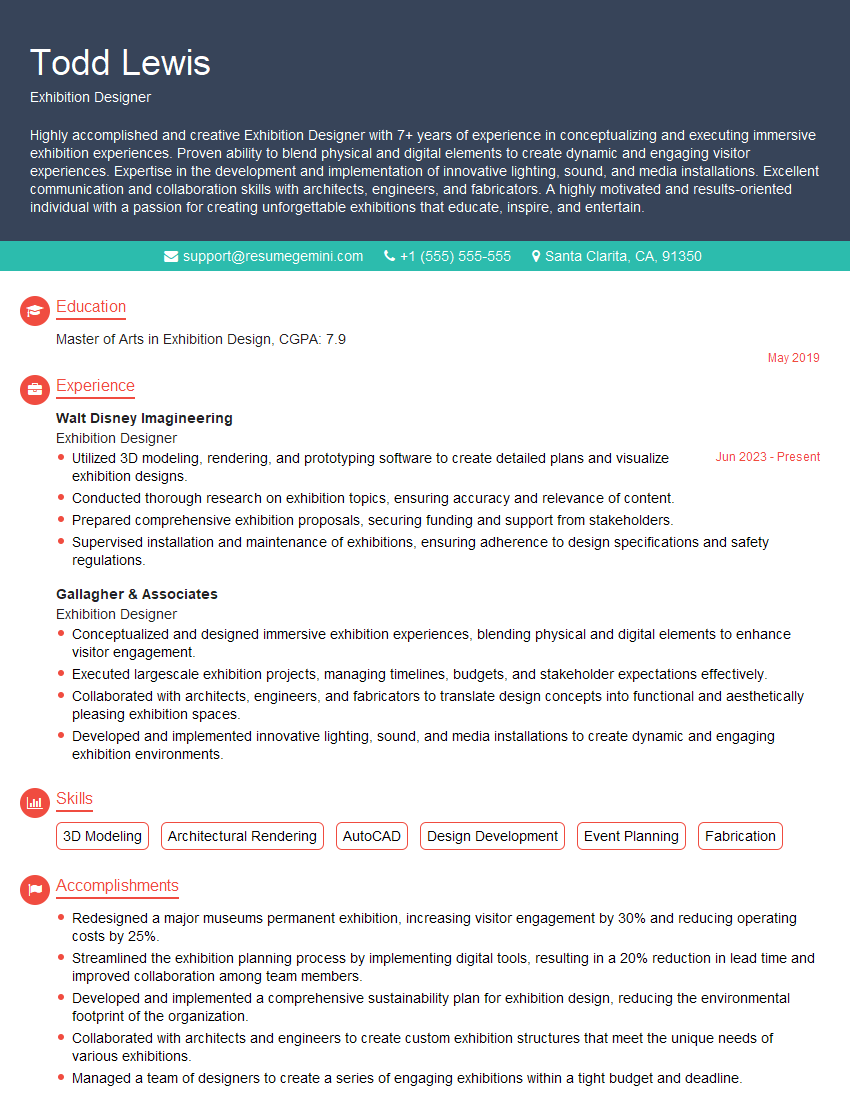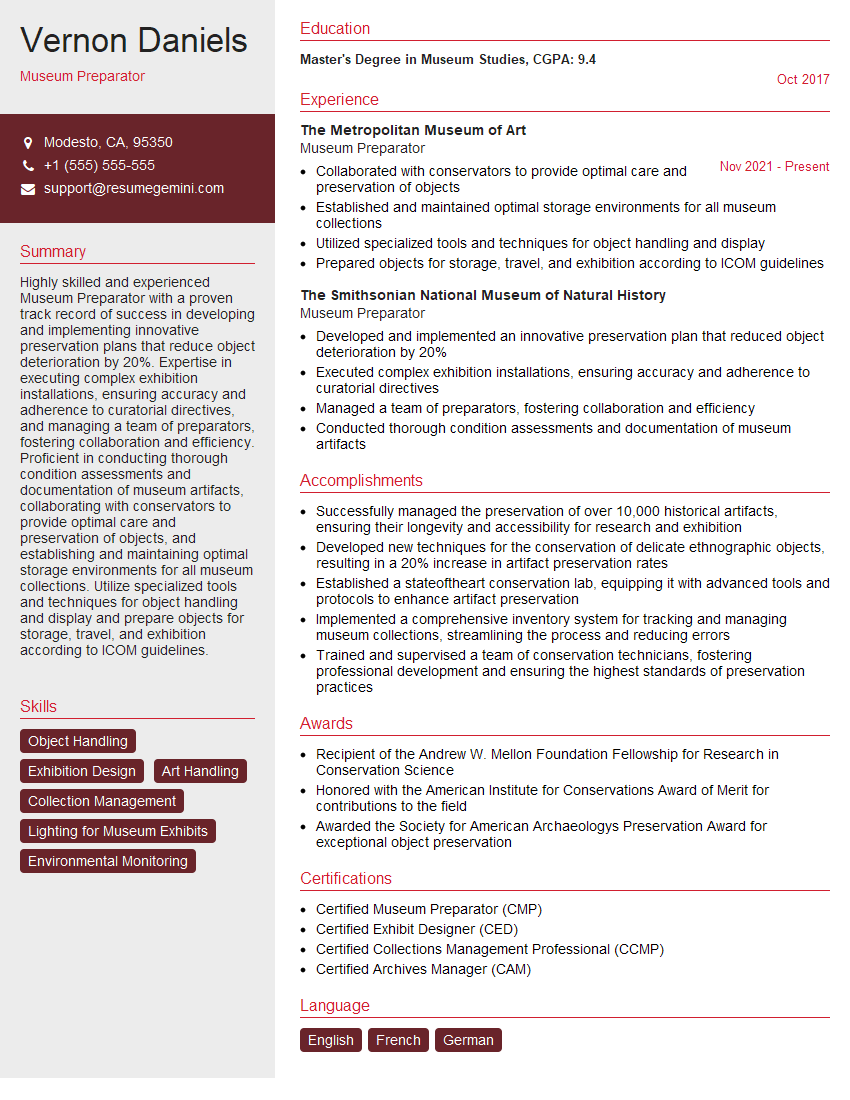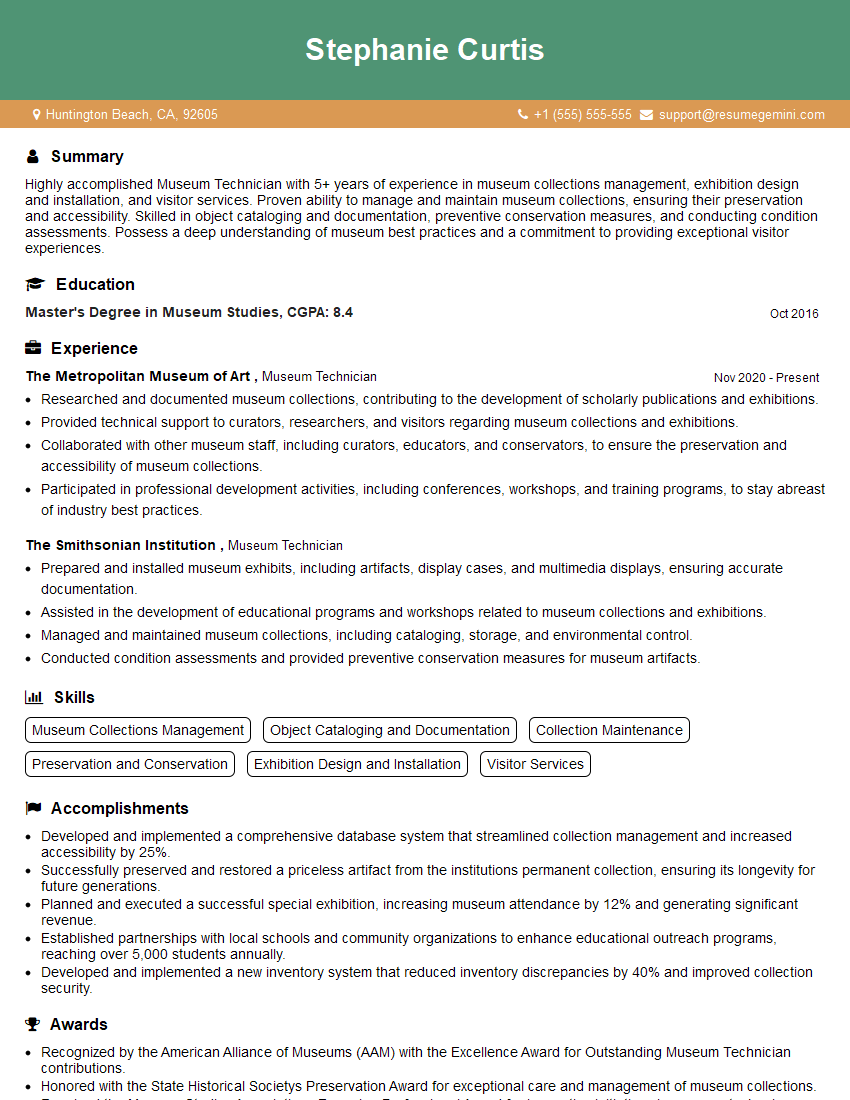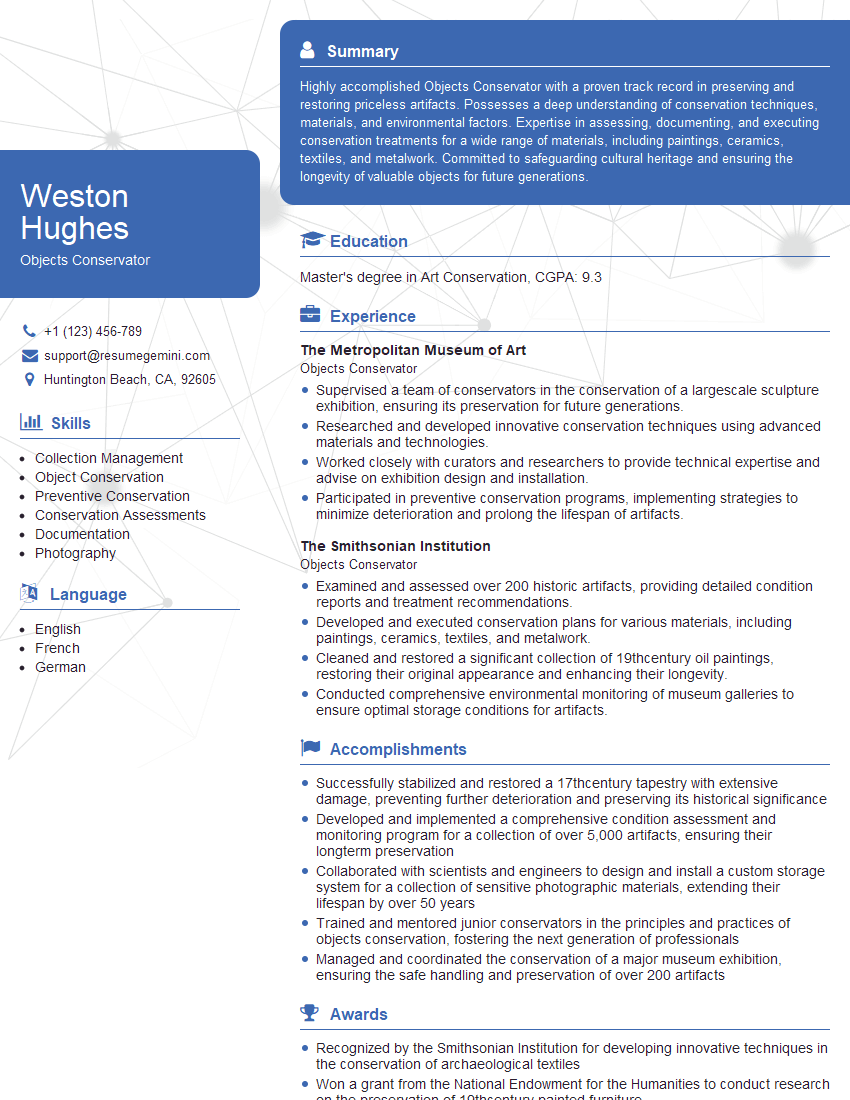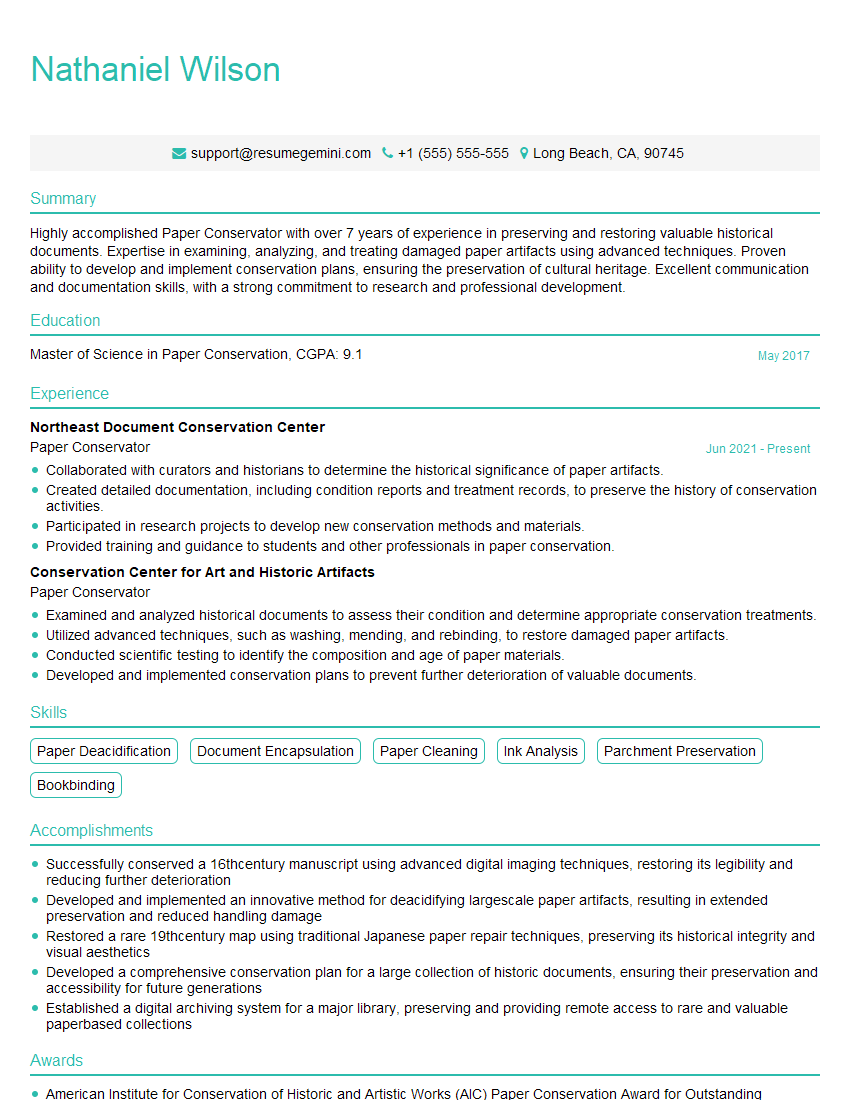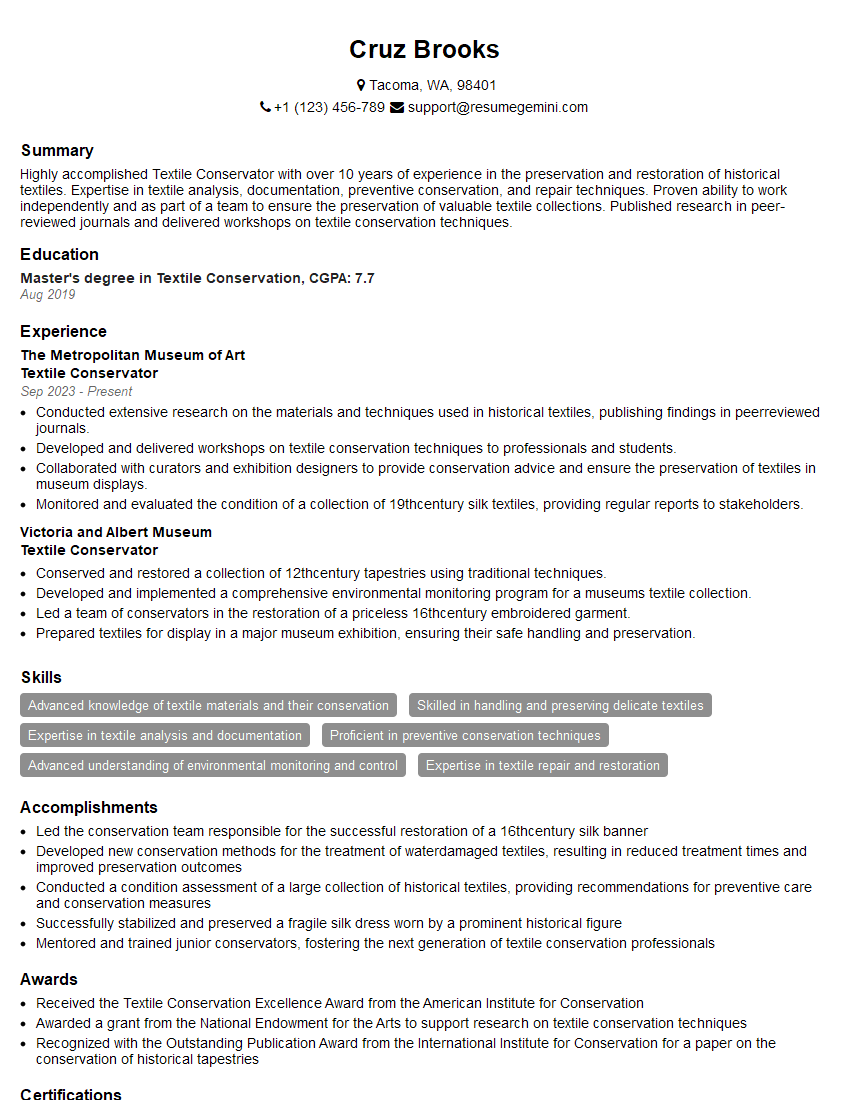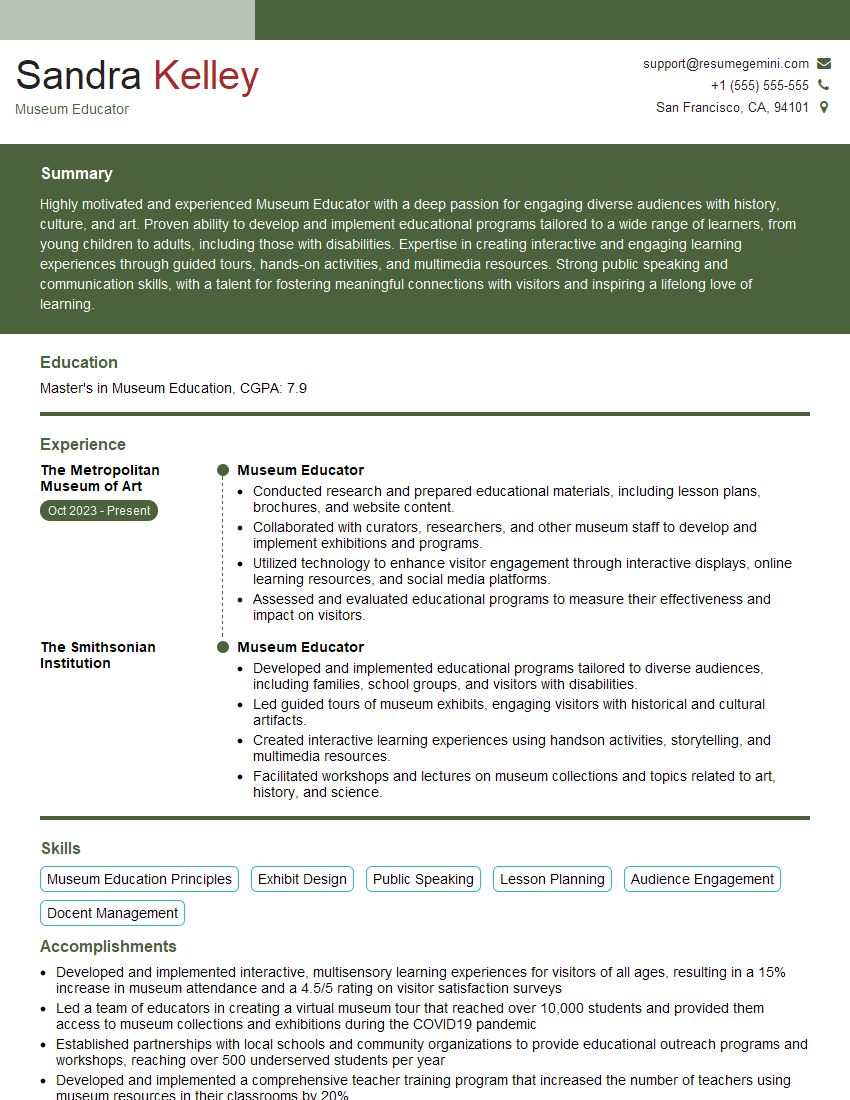Interviews are opportunities to demonstrate your expertise, and this guide is here to help you shine. Explore the essential Museum Standards interview questions that employers frequently ask, paired with strategies for crafting responses that set you apart from the competition.
Questions Asked in Museum Standards Interview
Q 1. Describe your experience with implementing museum best practices for collections storage.
Implementing best practices for collections storage in museums is crucial for preserving artifacts for future generations. It involves a multi-faceted approach encompassing environmental controls, proper handling, and organized storage systems. My experience includes developing and implementing storage plans for diverse collections, ranging from delicate textiles to large-scale sculptures.
For example, in a previous role at the City Museum, I oversaw the relocation of a large ethnographic collection. This involved meticulously planning the move, ensuring appropriate packing materials and climate-controlled transport, and implementing a new storage system based on object type and fragility. We used acid-free boxes, archival-quality tissue paper, and a dedicated climate-controlled storage area. We also implemented a detailed inventory system using a barcode system to track the location of each item and improve accessibility.
Another key aspect was staff training. We conducted comprehensive training sessions on proper handling techniques to prevent damage during access and re-shelving. This included demonstrations on the safe use of handling equipment and the importance of wearing appropriate gloves.
Q 2. Explain the significance of accessioning museum objects.
Accessioning is the formal process of documenting and accepting an object into a museum’s collection. It’s the cornerstone of collections management because it provides a permanent record of the object’s provenance (history of ownership), condition, and context. This is vital for research, legal compliance, and ethical considerations. Without accessioning, objects become essentially undocumented and their value for research and exhibition is severely diminished.
Think of it like giving an official identity to each object. Each accessioned item receives a unique accession number which becomes its permanent identifier throughout its life within the museum. The accession process also typically includes detailed photography, conservation assessment, and the creation of a detailed record within the museum’s database. This record contains information about the object’s acquisition, creator, material, dimensions, and any associated documentation.
A well-executed accessioning process ensures the long-term integrity and trustworthiness of the museum’s collection. It safeguards against loss, theft, and misidentification, supporting responsible stewardship of cultural heritage.
Q 3. How do you ensure the proper environmental controls for artifact preservation?
Maintaining proper environmental controls is paramount for artifact preservation. Environmental factors like temperature, relative humidity, and light levels can significantly affect an object’s condition, causing degradation, deterioration, and even destruction. My approach involves a combination of monitoring and control techniques.
For instance, I’ve implemented sophisticated environmental monitoring systems (EMS) in several museums. These systems continuously record temperature and relative humidity levels, alerting staff to any deviations outside pre-defined parameters. Data is typically logged and can often be accessed remotely, allowing for proactive intervention. In addition to EMS, I’ve been involved in the design and implementation of climate-controlled storage environments, specifying appropriate HVAC systems that maintain consistent temperature and humidity.
Controlling light exposure is crucial, too. UV and visible light can cause fading and deterioration, especially in organic materials like textiles and photographs. This is often managed through the use of UV-filtering glazing, controlled lighting levels, and keeping light exposure to a minimum. Regular inspections and preventative maintenance of the equipment are critical to ensuring the long-term stability of the environmental controls.
Q 4. What are the key elements of a museum’s collections management policy?
A museum’s collections management policy is a comprehensive document outlining procedures and protocols for managing the entire lifecycle of its collection. This policy serves as a guide for staff, ensuring consistency and ethical conduct. Key elements include:
- Acquisition Policy: Defines criteria for accepting new objects into the collection.
- Accessioning Procedures: Details the steps involved in formally documenting and adding an object to the collection.
- Storage and Handling Procedures: Outlines best practices for storing and handling objects to ensure their preservation.
- Cataloging and Database Management: Specifies the system for documenting and managing collection information.
- Conservation and Preservation Policies: Establishes guidelines for preventive and interventive conservation.
- Loans and Exhibitions Policy: Covers the process for loaning objects to other institutions or for inclusion in exhibitions.
- De-accessioning Policy: Describes the rigorous process for removing objects from the collection.
- Disaster Preparedness and Response Plan: Sets out procedures for protecting the collection in the event of a disaster.
A well-defined policy ensures legal compliance, facilitates effective management, and promotes the long-term sustainability of the collection.
Q 5. Describe your experience with cataloging and database management for museum collections.
My experience in cataloging and database management for museum collections involves working with various collection management systems (CMS). These systems are crucial for organizing, accessing, and analyzing vast amounts of data. I have extensive experience using both proprietary systems and open-source options such as TMS (The Museum System).
My role typically involves not only data entry and updating, but also developing and implementing database structures, designing data entry workflows, and providing training to staff. This often involves creating custom fields within the database to accommodate the unique requirements of different collections. For instance, I once worked on a project where we needed to add a field for recording the provenance of textiles, tracing their origin and ownership throughout their history. This involved careful consideration of data standards to ensure accuracy and consistency.
Data integrity and security are paramount. I have experience in implementing data validation procedures, regular backups, and access control measures to safeguard collection information.
Q 6. How do you handle discrepancies in collection records?
Discrepancies in collection records are inevitable, given the age and complexity of many museum collections. Addressing these requires a methodical and documented approach.
The first step is to identify and document the discrepancy. This might involve comparing information from different sources, such as accession records, object labels, and related archival materials. Then, I use a combination of research methods to resolve the issue. This could include reviewing historical records, consulting with experts, or using advanced imaging techniques (like X-ray or infrared analysis) if appropriate. If the discrepancy cannot be definitively resolved, it should be clearly documented and noted in the object’s record. Transparency is key here; the record should reflect the uncertainty.
For example, we discovered a discrepancy in the dimensions recorded for a particular artifact. Through careful comparison with original photographs and field notes, we were able to identify a typographical error in the original record and correct it. We maintained a log of the correction to maintain an audit trail.
Q 7. Explain your understanding of different conservation techniques.
My understanding of conservation techniques encompasses both preventive and interventive approaches. Preventive conservation focuses on mitigating environmental factors and minimizing the risk of damage, while interventive conservation involves direct treatment of damaged objects.
Preventive conservation strategies include proper storage (as discussed earlier), environmental control, and regular monitoring. Interventional conservation is more specialized and often requires expertise in specific materials. For instance, I’m familiar with techniques used to conserve textiles, such as surface cleaning, stain removal, and structural support. For paper-based materials, this could include de-acidification and repair techniques. For metal objects, it could include cleaning corrosion and stabilizing deterioration.
It’s important to remember that interventive conservation should only be undertaken by trained conservators. The process needs to be meticulously documented, including the materials used, the methods applied, and the results obtained. This is essential for maintaining a complete history of the object’s treatment and preservation.
Q 8. How do you prioritize conservation efforts with limited resources?
Prioritizing conservation efforts with limited resources requires a strategic approach. We need to balance urgency with long-term preservation goals. This involves a rigorous process of assessment and prioritization.
- Risk Assessment: We begin by assessing the condition of each object, identifying those most at risk of deterioration. This might involve factors like material instability, environmental vulnerability (e.g., light sensitivity, susceptibility to pests), or existing damage. Objects with high intrinsic value or historical significance often take precedence.
- Cost-Benefit Analysis: Each conservation treatment has associated costs (labor, materials, specialized equipment). We carefully weigh the cost of treatment against the potential benefits in terms of preservation and risk reduction. Sometimes, preventative conservation measures (like environmental control) are more cost-effective in the long run than individual object treatments.
- Triaging and Prioritization: We use a matrix to rank objects based on their condition, significance, and treatment costs. This allows us to focus resources on the most critical interventions first. This might involve stabilizing severely damaged objects before addressing less urgent concerns.
- Collaboration and Grants: We actively seek collaboration with other institutions and apply for grants to supplement our limited resources. This allows us to leverage external expertise and funding to support larger-scale conservation projects.
For example, in one project, we prioritized the conservation of a historically significant textile facing significant light damage, given its irreversible degradation. We chose a less expensive, but effective, method of UV filtering over more costly treatments.
Q 9. Describe your experience with disaster preparedness and recovery plans for museum collections.
Disaster preparedness is paramount in museum work. Our plans address a range of potential threats, from natural disasters (floods, earthquakes, fires) to human-caused incidents (theft, vandalism). These plans are not static documents; they are living documents that are regularly reviewed and updated based on risk assessments and recent events.
- Risk Assessment and Mitigation: We conduct regular risk assessments to identify vulnerabilities, including building structure, environmental conditions, and security systems. This informs the development of mitigation strategies.
- Emergency Response Plan: This plan details step-by-step procedures for different scenarios, including evacuation procedures, securing collections, and coordinating with emergency services. It outlines roles and responsibilities for staff members.
- Collection Security Measures: We utilize a multi-layered security system, including security cameras, alarms, environmental monitoring, and restricted access controls to deter theft or vandalism.
- Environmental Controls: We maintain stable environmental conditions (temperature, humidity) to minimize deterioration and reduce vulnerability to environmental damage.
- Disaster Recovery Plan: This plan outlines procedures for recovering from a disaster, including salvage operations, documentation of damage, conservation treatment, and the rebuilding of the collection’s infrastructure.
During a recent flood threat, our emergency response plan worked seamlessly. We successfully evacuated vulnerable collections to a safe location and saved numerous irreplaceable artifacts thanks to proactive measures and the well-defined roles and responsibilities detailed in our plan.
Q 10. How do you assess the condition of museum objects?
Condition assessment involves a thorough examination of an object to determine its overall state of preservation. This is a multi-step process which often combines visual inspection with scientific analysis.
- Visual Examination: We begin with a detailed visual inspection, noting any visible damage (cracks, stains, tears), signs of deterioration (fading, flaking), or previous repairs. We document these findings using photography and detailed written reports.
- Material Identification: Identifying the object’s constituent materials is crucial for understanding its vulnerabilities and developing appropriate conservation strategies. This may involve scientific analysis techniques.
- Scientific Analysis: For more detailed assessment, we may employ non-invasive techniques such as X-ray, infrared, or ultraviolet imaging to identify internal damage or material composition without causing further harm. This helps uncover hidden issues not visible to the naked eye.
- Documentation: All findings are meticulously documented with high-resolution photographs, detailed descriptions, and condition reports. This documentation serves as a baseline for monitoring the object’s condition over time and informing future conservation interventions.
For instance, assessing a painted wooden sculpture might involve visually inspecting for cracks and paint loss, identifying the type of wood and paint, and using X-rays to detect internal woodworm damage. Each observation is carefully documented to guide appropriate conservation treatment.
Q 11. What are the ethical considerations in handling and managing museum collections?
Ethical considerations are central to museum work. Our actions must respect the objects’ cultural heritage, their provenance, and their significance to communities.
- Repatriation: Museums have an ethical responsibility to consider the repatriation of objects to their communities of origin if they were acquired under questionable circumstances. This requires sensitivity to the concerns and rights of Indigenous groups and other communities.
- Respect for Cultural Heritage: Handling and displaying objects should demonstrate respect for their cultural significance and avoid causing offense or misrepresentation.
- Transparency and Access: Information about the objects’ origins, history, and significance should be readily accessible to the public. This promotes transparency and educational engagement.
- Stewardship: Museums act as stewards of collections, ensuring their long-term preservation for future generations. This responsibility includes making informed decisions based on ethical considerations.
- Collection Development: Ethical considerations guide decisions related to acquiring new objects, ensuring that acquisitions are made in a way that respects cultural heritage and legal frameworks.
For example, we recently reviewed our collection for any potentially problematic acquisitions and initiated discussions with relevant communities to address issues of provenance and potential repatriation.
Q 12. Explain your understanding of intellectual property rights related to museum objects.
Intellectual property rights related to museum objects are complex and multifaceted. They can encompass copyright, trademarks, and other forms of intellectual property. Understanding and respecting these rights is crucial.
- Copyright: Copyright protects artistic works incorporated into objects or related documentation, such as photographs or written descriptions. Museums must respect the copyright of creators and seek permission before reproducing or publishing copyrighted materials.
- Trademarks: Trademarks protect brand names and logos that may appear on objects. Museums need to be aware of trademark laws when displaying or reproducing objects with trademarks.
- Moral Rights: Certain jurisdictions recognize moral rights for creators, which allow them to claim authorship and object to distortions of their work. Museums need to respect these rights when handling and displaying objects.
- Indigenous Knowledge: Museums must also be aware of and respect intellectual property rights related to traditional knowledge, designs, and cultural expressions held by indigenous communities. This includes seeking permission and acknowledging the cultural source of such knowledge.
- Attribution and Acknowledgement: Proper attribution and acknowledgement are essential when presenting information about objects, particularly regarding creators, communities, and sources of knowledge.
For instance, before reproducing a photograph of a painting, we must verify the copyright status and obtain permission from the copyright holder.
Q 13. How do you ensure the security and safety of museum collections?
Ensuring the security and safety of museum collections involves a comprehensive, multi-layered approach encompassing physical security, environmental controls, and staff training.
- Physical Security: We employ robust physical security measures including alarm systems, surveillance cameras, controlled access systems, and security personnel. These deter theft and vandalism.
- Environmental Controls: Maintaining stable environmental conditions (temperature, humidity, light levels) is crucial in preventing deterioration and reducing the risk of damage from environmental factors.
- Emergency Preparedness: Having well-defined emergency response and disaster recovery plans is vital for protecting the collection from unexpected events such as fires, floods, or earthquakes. This includes emergency procedures and drills.
- Staff Training: Regular training for staff on security protocols, emergency procedures, and handling techniques helps to minimize risks and ensure that everyone understands their roles and responsibilities.
- Storage and Handling Procedures: Proper storage and handling procedures, tailored to the specific needs of each object, minimize the risk of damage during handling, transport, or storage.
For instance, our museum utilizes a sophisticated alarm system linked to a 24/7 security monitoring service and regularly conducts emergency evacuation drills to ensure staff readiness.
Q 14. Describe your experience with handling fragile or valuable artifacts.
Handling fragile or valuable artifacts requires specialized skills, equipment, and meticulous attention to detail.
- Assessment and Planning: We begin by carefully assessing the object’s condition, identifying any fragile areas or potential hazards. This informs the handling procedures.
- Specialized Equipment: We utilize appropriate handling equipment, such as padded gloves, supports, and specialized lifting devices, to minimize the risk of damage.
- Controlled Environment: Working in a controlled environment, often a conservation lab, provides the optimal setting for handling fragile artifacts. This helps control dust, light, and temperature to prevent further damage.
- Trained Personnel: Only trained personnel with experience in handling delicate objects should undertake this work. This ensures that handling procedures are followed carefully and that any potential problems are addressed safely.
- Detailed Documentation: Every step of the handling process is meticulously documented, including photographic records, to ensure accountability and track any interventions.
For instance, when handling a delicate Ming dynasty vase, we would use padded gloves, a specialized lifting device, and photographic documentation to ensure its safe movement and prevent any damage.
Q 15. What are the key components of a successful museum exhibition?
A successful museum exhibition hinges on a delicate balance of several key components. It’s not just about displaying artifacts; it’s about crafting a compelling narrative that engages visitors on an intellectual and emotional level.
- A strong narrative arc: The exhibition must tell a story, whether chronological, thematic, or biographical. This narrative provides context and meaning for the objects on display. For example, an exhibition on the history of flight might trace the evolution of aircraft design, highlighting key innovations and individuals.
- Object selection and presentation: Careful curation is crucial. Objects must be relevant to the narrative, well-preserved, and displayed in a manner that is both aesthetically pleasing and informative. Consider using varied display techniques – from traditional showcases to interactive digital elements – to enhance engagement.
- Engaging interpretation: Labels, wall text, and other interpretive materials must be clear, concise, and accessible to a wide audience. Consider employing multimedia elements like videos, audio recordings, and interactive kiosks to enhance understanding and accessibility.
- Visitor experience: The overall visitor experience should be considered, from the layout and flow of the exhibition space to the availability of amenities like restrooms and seating. Accessibility for visitors with disabilities is paramount.
- Evaluation and feedback: A successful exhibition constantly evolves. Post-exhibition evaluations, including visitor feedback surveys and staff debriefs, inform future improvements and exhibitions.
Career Expert Tips:
- Ace those interviews! Prepare effectively by reviewing the Top 50 Most Common Interview Questions on ResumeGemini.
- Navigate your job search with confidence! Explore a wide range of Career Tips on ResumeGemini. Learn about common challenges and recommendations to overcome them.
- Craft the perfect resume! Master the Art of Resume Writing with ResumeGemini’s guide. Showcase your unique qualifications and achievements effectively.
- Don’t miss out on holiday savings! Build your dream resume with ResumeGemini’s ATS optimized templates.
Q 16. Explain your understanding of museum accreditation standards.
Museum accreditation standards, such as those set by organizations like the American Alliance of Museums (AAM) in the US, represent a comprehensive set of best practices for museum operations. They ensure that museums operate ethically, responsibly, and effectively in their mission to preserve and share cultural heritage. These standards cover a wide range of areas, including:
- Collections management: This encompasses all aspects of acquiring, documenting, preserving, and managing museum collections, ensuring the long-term survival of artifacts.
- Governance and ethics: This involves establishing clear organizational structures, ethical guidelines, and financial accountability, ensuring transparency and responsible stewardship.
- Education and public programs: Accreditation requires museums to demonstrate a commitment to education and outreach, making their collections and knowledge accessible to diverse audiences.
- Facilities and security: Museums must meet specific standards for the physical security and environmental control of their collections and facilities, preserving objects from damage and theft.
- Personnel and professional development: Accreditation emphasizes the importance of skilled staff and ongoing professional development to ensure high standards of practice.
Achieving and maintaining accreditation demonstrates a museum’s commitment to excellence and builds public trust. It’s a rigorous process involving a thorough self-study and an on-site review by peers.
Q 17. How do you contribute to the ongoing development of museum standards?
My contribution to the ongoing development of museum standards involves active participation in professional organizations, attending conferences, and engaging in discussions surrounding best practices. I believe in staying abreast of current research and technological advances in conservation science, collections management, and exhibition design. For example, I’ve presented papers on the application of new imaging technologies for condition assessment at international museum conferences. Furthermore, I actively mentor younger professionals, sharing my expertise and helping them to become future leaders in the field. Sharing knowledge and participating in setting new standards ensures that our institutions are continually improving.
Q 18. Describe your experience with creating condition reports for museum objects.
Creating condition reports is a cornerstone of responsible collections management. I meticulously document the physical state of each object, using standardized terminology and photographic documentation. This involves a thorough visual examination, noting any signs of deterioration, damage, or previous repairs. For example, for a painting, I’d note the presence of cracks in the paint layer (craquelure), any areas of flaking or loss of paint, and the condition of the canvas support. The report would also include details about the object’s environmental conditions and storage location. I use specialized software to generate detailed reports that are easily accessible and auditable, and the information is crucial for making informed decisions regarding conservation treatment and preventative measures.
Q 19. How do you collaborate with other museum professionals?
Collaboration is essential in museum work. I regularly collaborate with conservators, registrars, curators, educators, and other professionals. For example, when planning a new exhibition, I’ll work closely with curators to select objects, with conservators to determine the feasibility of display, and with registrars to manage loans. Collaboration allows us to leverage each other’s expertise to create comprehensive and impactful projects. We often utilize project management software and regular meetings to ensure seamless communication and coordination across departments.
Q 20. What are your strategies for managing large-scale collections projects?
Managing large-scale collections projects demands a structured approach. I employ project management methodologies, such as the use of Gantt charts to visualize timelines and dependencies between tasks. This includes defining clear goals, establishing detailed work plans, and assigning responsibilities to team members. Effective communication is crucial; we utilize regular progress meetings, shared digital platforms, and detailed documentation to track progress and address challenges proactively. A key aspect is risk assessment and mitigation planning, identifying potential problems in advance to minimize disruptions to the project. Finally, careful budgeting and resource allocation are essential for ensuring project success.
Q 21. How do you handle conflicting priorities in collections management?
Conflicting priorities are inevitable in collections management. My approach involves a systematic prioritization process. I start by clearly defining all priorities, often using a weighted matrix to assess their relative importance, considering factors such as the urgency, the impact on collections preservation, and alignment with institutional strategic goals. This allows for transparent decision-making. For example, we might prioritize the conservation of a highly vulnerable object over the cataloging of a less fragile collection in the short term. Open communication with all stakeholders is critical to ensuring everyone understands the rationale behind the decisions made.
Q 22. Describe your experience with inventory management for museum collections.
Inventory management in museums is the backbone of collections care. It’s a meticulous process of accurately documenting, tracking, and managing every single object within a collection. This involves assigning unique identification numbers, recording detailed descriptions (including materials, dimensions, and condition), and maintaining a comprehensive database of object location and history. Think of it like a highly sophisticated, constantly updated library catalog, but for priceless artifacts!
In my experience, I’ve used various methods, from spreadsheet-based systems in smaller museums to sophisticated database management systems like TMS (The Museum System) in larger institutions. The key is accuracy and consistency. A single missing detail can compromise the entire system’s integrity. For instance, I once worked on a project where a seemingly insignificant discrepancy in a textile’s description led to the rediscovery of a previously unknown repair, providing valuable information about its history. Proper inventory management is crucial for insurance purposes, loan requests, and conducting research on the collection.
- Database Management: Ensuring data integrity through regular backups and data validation.
- Physical Verification: Regularly comparing database records with physical objects to identify discrepancies or losses.
- Barcode/RFID Integration: Implementing technologies for efficient tracking and verification.
Q 23. Explain your understanding of the role of documentation in collections management.
Documentation is paramount in collections management; it’s the lifeblood of preserving the collection’s context and history. It’s not just about listing the object; it’s about creating a rich narrative around it. This involves detailed descriptions, provenance research (tracing its ownership history), photographs, condition reports, conservation records, and even oral histories related to the object. Think of it as building a comprehensive dossier for each object, allowing future generations to understand its significance.
I’ve been involved in numerous projects requiring extensive documentation, from creating detailed condition reports for fragile artifacts to undertaking thorough provenance research. A compelling example was documenting a collection of 19th-century photographs. Beyond basic cataloging, we recorded the photographic techniques used, the identities of the sitters (when possible), and the historical context of the images, enriching the narrative far beyond simple descriptive data. Without rigorous documentation, valuable objects can become mere objects, losing their historical and cultural significance.
Q 24. How do you evaluate the effectiveness of conservation treatments?
Evaluating the effectiveness of conservation treatments requires a multi-faceted approach. It’s not enough to just say ‘it looks better.’ We must assess the treatment’s impact on the object’s long-term stability and its aesthetic integrity. This involves pre-treatment documentation, detailed treatment records, regular post-treatment monitoring, and sometimes, scientific analysis.
My approach involves comparing pre- and post-treatment condition reports, scrutinizing the conservator’s treatment documentation, and if necessary, employing non-invasive techniques like X-ray or infrared imaging to assess the treatment’s effect on the object’s internal structure. For example, after a canvas painting underwent cleaning and lining, I used infrared reflectography to confirm the treatment hadn’t damaged the underlying paint layers. Effectiveness is measured not only by immediate visual improvement but also by the long-term preservation of the object.
Q 25. Describe your experience with developing and implementing collection policies.
Developing and implementing collection policies is crucial for establishing consistent standards and best practices. These policies are the rules that guide all aspects of collections management, from acquisitions and deaccessions to storage and handling. They should be comprehensive, addressing ethical considerations, environmental controls, legal compliance (such as repatriation policies), and disaster preparedness.
In my past role, I was involved in developing a new collection policy for a museum undergoing significant expansion. This involved consultations with curatorial staff, conservators, registrars, and legal counsel. We addressed issues such as object acquisition procedures, loan agreements, ethical considerations related to culturally sensitive objects, and the establishment of strict environmental monitoring protocols for storage areas. The policy was ultimately approved by the museum’s board and continues to guide collections management to this day. A well-structured policy ensures the responsible management and preservation of the collection for generations.
Q 26. What software or systems are you proficient in for collections management?
I’m proficient in several software systems for collections management. My experience includes working with TMS (The Museum System), PastPerfect, and CollectionsSpace. These systems provide tools for cataloging objects, managing loans, tracking conservation treatments, and generating reports.
I also have experience with specialized software for digital asset management (DAM) systems like CONTENTdm, which are vital for managing and preserving digital collections. The choice of software depends on the size and complexity of the collection and the museum’s specific needs. I’m adept at adapting my skills to different systems and training staff in their efficient use. Understanding database structures and data migration between systems is a crucial skill.
Q 27. How do you ensure the long-term preservation of digital collections?
Ensuring the long-term preservation of digital collections presents unique challenges. Unlike physical objects, digital files are susceptible to technological obsolescence, data corruption, and format degradation. A proactive, multi-layered approach is essential.
This involves employing best practices such as using open-source file formats, creating multiple backups on different media (cloud storage, hard drives, etc.), regularly migrating data to current technologies, and implementing a robust digital preservation policy that addresses metadata standards, access control, and disaster recovery planning. Furthermore, employing checksums or other forms of digital signatures for authenticity verification is crucial. It’s like having several copies of your important documents stored in various locations, updated regularly to prevent loss.
Q 28. Explain your understanding of preventative conservation measures.
Preventative conservation focuses on minimizing the deterioration of objects before they require active intervention. It’s a proactive approach emphasizing environmental control, proper handling, and appropriate storage. Think of it as preventative medicine for your collection—far cheaper and more effective than emergency treatment.
Key measures include maintaining stable environmental conditions (temperature, humidity, light levels), using appropriate storage materials (acid-free boxes, archival quality envelopes), implementing pest control measures, and providing staff with training on proper handling techniques. For example, controlling humidity is critical for preventing mold growth on paper-based materials and reducing the expansion and contraction of wood. A well-planned preventative conservation program can significantly extend the lifespan of a museum’s collection and reduce the need for expensive restorative treatments.
Key Topics to Learn for Museum Standards Interview
- Collection Management: Understanding principles of acquisition, accessioning, cataloging, storage, and preservation of museum objects. Practical application: Describe your experience with a specific collection management system or database.
- Object Handling and Care: Best practices for the safe handling, transport, and environmental control of artifacts. Practical application: Explain how you would address a situation involving damaged artifacts.
- Conservation Ethics: Adherence to ethical guidelines in conservation treatments and preventative measures. Practical application: Discuss a scenario requiring ethical decision-making in object conservation.
- Documentation and Metadata: Importance of accurate, consistent, and comprehensive documentation for museum objects, including metadata schemas and standards (e.g., Dublin Core). Practical application: Explain your experience with creating or working with museum object records.
- Exhibition Design and Installation: Principles of effective exhibition design considering security, accessibility, environmental controls and narrative flow. Practical application: Describe your involvement in a past exhibition, highlighting your contribution.
- Museum Security and Risk Management: Strategies for protecting collections from theft, damage, and environmental hazards. Practical application: Discuss your experience in developing or implementing security protocols.
- Legal and Ethical Considerations: Understanding laws and ethical responsibilities concerning ownership, repatriation, and intellectual property rights. Practical application: Describe a situation where legal or ethical concerns played a significant role in your work.
- Accessibility and Inclusivity: Creating museum experiences accessible to diverse audiences, including individuals with disabilities. Practical application: Explain your knowledge of ADA compliance or inclusive exhibit design principles.
Next Steps
Mastering Museum Standards is crucial for career advancement in the museum field, opening doors to exciting opportunities and demonstrating your commitment to best practices. To maximize your chances of success, invest in creating an ATS-friendly resume that highlights your relevant skills and experience. ResumeGemini is a trusted resource to help you build a professional and impactful resume that catches the eye of recruiters. Examples of resumes tailored to Museum Standards are available below to guide you. Use these resources to showcase your expertise and land your dream job!
Explore more articles
Users Rating of Our Blogs
Share Your Experience
We value your feedback! Please rate our content and share your thoughts (optional).
What Readers Say About Our Blog
Hi, I represent an SEO company that specialises in getting you AI citations and higher rankings on Google. I’d like to offer you a 100% free SEO audit for your website. Would you be interested?
good
